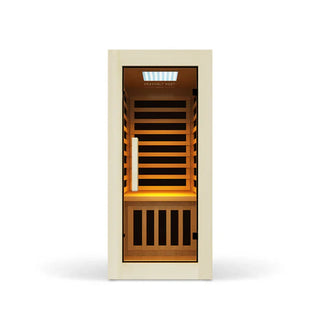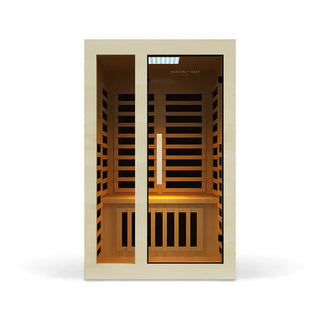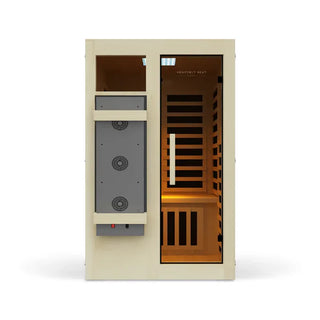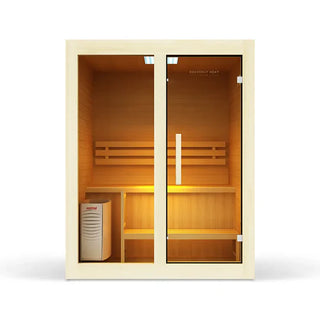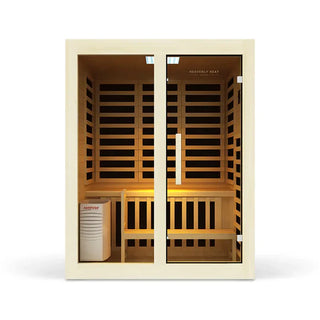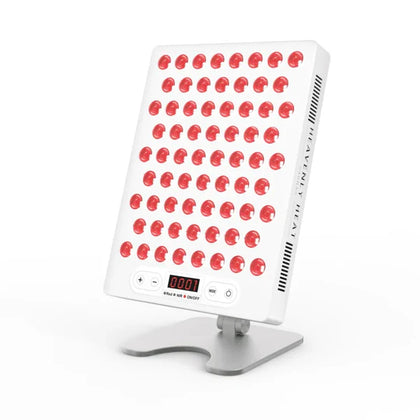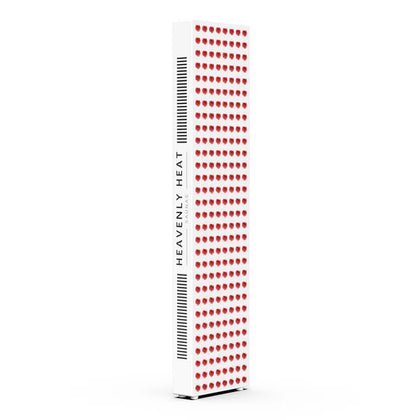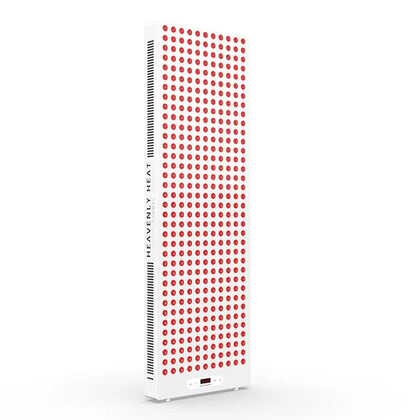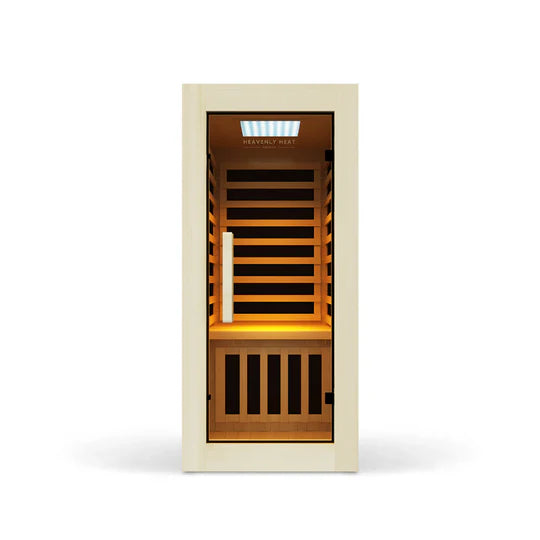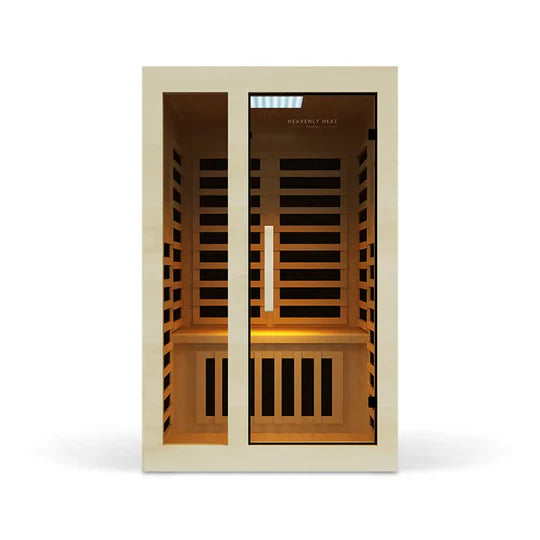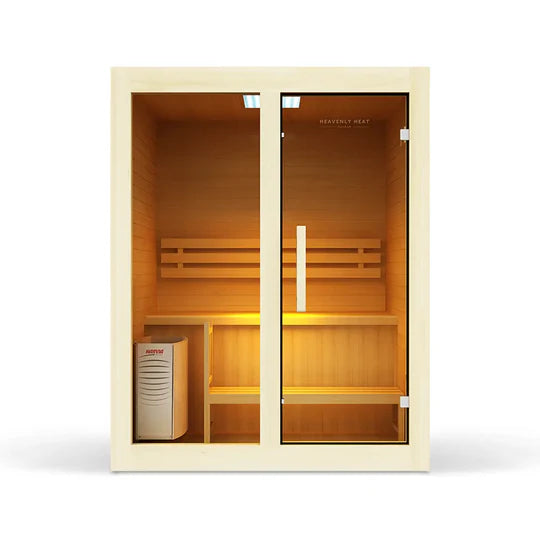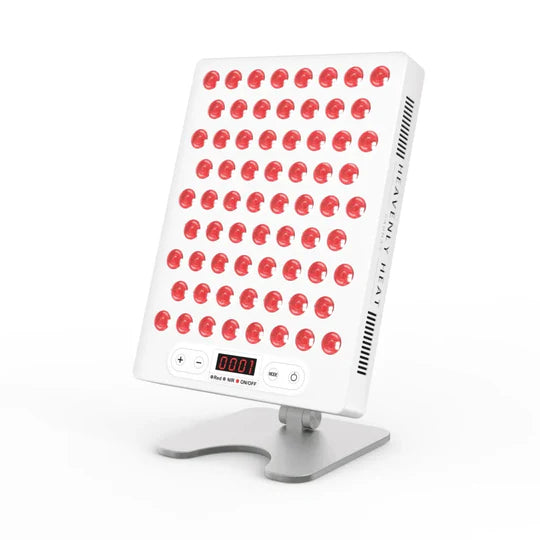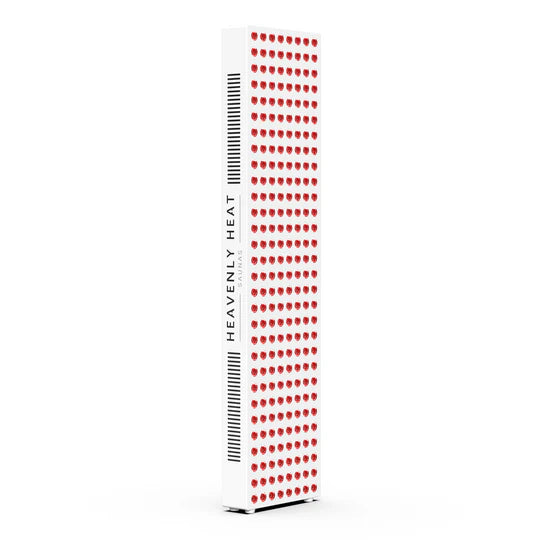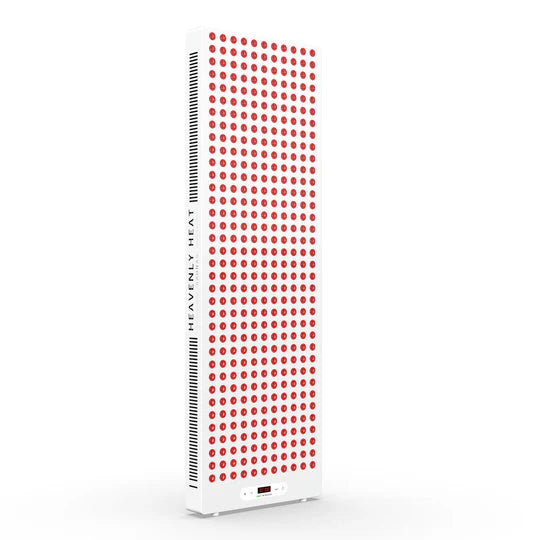What is The Difference Between Infrared Sauna And Red Light Therapy?

Curious about the glow of infrared saunas or the magic of red light therapy? Both offer amazing benefits like improved skin, relaxation, and recovery, but understanding the difference can be tricky.
Feeling unsure about which is right for you? Don't stress, this guide will break it all down and help you make an informed choice!
What Are Infrared Saunas and Red Light Therapy?
Infrared saunas and red light therapy are both popular treatments used for health and wellness.
Infrared saunas heat the body directly, not the surrounding air, helping you warm up more efficiently, says Dr. Brent A. Bauer, director of the Mayo Clinic Complementary and Integrative Medicine Program. Infrared saunas use heat to penetrate your skin, helping your body relax and potentially offering benefits like improved circulation.
Red light therapy uses specific wavelengths of light to target cells and tissues, aiding in healing and reducing inflammation. This type of therapy also boosts the production of basic fibroblast growth factor, which supports collagen production and promotes skin and joint healing. While results may vary, most people begin to notice improvements after a few weeks of consistent red light therapy sessions, not immediately. Patience plays a key role in achieving the best outcomes .
Both therapies provide relaxation, better skin health, and recovery, but each treatment targets specific health concerns in its own way.

Why Compare Infrared Saunas and Red Light Therapy?
Infrared saunas and red light therapy may seem similar, but they offer unique benefits, making it important to understand which one fits your goals. A common mix-up is thinking they use the same type of light—red light therapy focuses on visible wavelengths, while infrared saunas use a broader, deeper-heating infrared range.
They work differently as infrared saunas use heat to penetrate deeper into your body, while red light therapy targets your skin and cells in a more focused way.
This means their benefits are not the same, so choosing the right one depends on what you need. Want both? You can combine them for maximum results.
Below, we will break down their key differences and benefits, so you can make an informed decision and get the most out of your wellness routine.
Infrared Light vs. Red Light: What’s the Difference?
Infrared Light Is Invisible to the Human Eye, While Red Light Is Visible
Red light is visible because it falls within the range of light our eyes can detect, while infrared light is invisible. “Near-infrared light has a longer wavelength, allowing it to penetrate deeper into tissues,” says Dr. Connie Yang, a board-certified dermatologist.
Even though we can’t see infrared light, we can feel its warmth on the skin. Red light, on the other hand, does not produce much heat but affects the body in other ways by penetrating the skin and interacting with cells. But if the eyes stay exposed to intense red light or the wrong wavelengths for too long, it can harm the retina and cause vision issues, or even lead to discomfort from phototoxicity.
Infrared Light Penetrates Deeper into the Body Than Red Light
When comparing infrared light and red light, one key difference lies in how deeply each can penetrate the skin.
Red light, visible to the human eye, has a shorter wavelength, making it ideal for addressing surface-level concerns like wrinkles and skin healing.
Red light typically penetrates about two to seven millimeters into the body, says Dr. Anetta Reszko. Specific wavelengths in red light therapy enhance mitochondrial function in retinal cells, offering potential protective benefits against age-related vision decline—a mechanism distinct from infrared saunas' systemic effects.
On the other hand, near-infrared light has a longer wavelength, allowing it to reach deeper into the tissues and target muscle soreness, joint pain, and inflammation.
Infrared light therapy can penetrate up to two and a half inches, heating the body from the inside out, shares Dr. Jonathan Leary.
The deeper penetration of infrared light helps it address issues below the skin, offering significant therapeutic benefits, says Dr. Connie Yang.
Infrared Light Produces More Heat Compared to Red Light
Infrared light emits noticeable heat that can warm the body from within, creating a comfortable, relaxing experience.
In contrast, red light produces very little heat, focusing solely on delivering light energy. This difference makes infrared ideal for relaxation and detoxification, while red light suits those seeking non-heating treatments.
The heat from infrared boosts circulation and eases muscle tension, whereas red light supports cellular repair without raising your body temperature.
Both Infrared and Red Light Offer Therapeutic Benefits, but in Different Ways
The purposes of infrared and red light therapy differ based on how each interacts with the body. Infrared light reaches deeper levels, while red light concentrates on surface layers. This distinction shapes how each therapy is applied and what it’s designed to support. Red light therapy has also been clinically shown to stimulate hair follicles and promote growth in cases of pattern baldness, working at the cellular level to revive dormant follicles. When used together, red and infrared light may be most effective for treating joint pain, inflammation, and skin conditions like psoriasis and acne. These differences matter because they determine how energy is used to influence various levels of the body.
Infrared and Red Light Affect Cells Differently at the Molecular Level
Both infrared and red light impact cells, but they differ in their depth and focus. Infrared targets deeper tissues, promoting cellular activity below the surface, while red light interacts more with surface-level cells.
These differences matter because they determine how energy is used to influence various levels of the body.
Different Technologies Are Used to Generate Infrared and Red Light
Infrared saunas use infrared heaters to warm the body directly, increasing heat and promoting sweating. "Infrared heat penetrates deeper into the body compared to traditional heat, making it more effective for muscle relaxation," says Dr. Vivian Eisenstadt, a physical therapist. Red light therapy uses LED panels or lasers to deliver light without heat, targeting cells for healing. Infrared saunas focus on relaxation and circulation, while red light therapy helps with skin, muscle recovery, and pain relief. Unlike targeted red/infrared therapies, traditional chromotherapy uses broad-spectrum colored lights (like blue or green) primarily for psychological effects, such as mood regulation, rather than for cellular or thermal benefits.
Health Benefits: Infrared Saunas vs. Red Light Therapy
Enhances the Body’s Natural Detoxification Process
Detoxification is your body's way of removing harmful toxins. Infrared saunas help by making you sweat, which helps get rid of toxins through your skin. "Longer sauna sessions are needed to enhance the mobilization of heavy metals and chemical xenobiotics," says Dr. Walter Crinnion, a naturopathic expert in environmental medicine. which studies health issues caused by external physical, chemical, and biological factors, helping address such detoxification needs.
But staying too long in a sauna can make you dehydrated or feel unwell, so it's important to be careful.
Red light therapy speeds this up by improving how your cells work and reducing stress, making detox faster.
Together, they support your body's natural cleansing process, leaving you feeling more energized and refreshed.

Stimulates Collagen Production for Healthier Skin
Collagen is a protein that keeps your skin smooth and your joints strong. Collagen provides structure and support, helping skin cells grow and replacing dead skin cells. As you age, your body produces less collagen, leading to wrinkles and sagging skin.
Red light therapy helps by stimulating the cells responsible for making collagen, which results in firmer and more youthful skin.
It works by giving energy to your cells, which boosts collagen and elastin production, says Dr. Anthony Youn, a Stanford physician. Elastin, a stretchy protein, helps skin return to its original shape, enhancing firmness and elasticity. Infrared saunas improve blood flow by expanding blood vessels and increasing circulation.
This means more oxygen and nutrients reach your skin and tissues, which are essential for collagen production. For lasting stress-reducing effects, aim for 3 to 5 sauna sessions each week.
The improved circulation from infrared saunas supports the body’s ability to create more collagen, helping your skin stay tight and your joints stay strong. With more collagen, you'll notice healthier, more vibrant skin and better joint flexibility.
Improves Blood Circulation and Oxygen Flow
Good circulation means your blood is flowing well, bringing oxygen and nutrients to your body.
Infrared saunas improve circulation by expanding your blood vessels and raising your heart rate, which delivers more oxygen to your cells.
Red light therapy also improves blood flow by helping your blood vessels relax and widen.
A study shows that when red light (670 nm) hits your skin, it triggers the release of a substance from the blood vessel lining that helps widen the vessels.
This process relies on nitric oxide and improves blood flow. Better circulation leads to more energy, faster recovery from exercise, and healthier skin.
Provides Effective Relief from Muscle and Joint Pain
Infrared saunas and red light therapy both offer pain relief, but they work in different ways. A study on chronic pain patients found that those who combined far-infrared sauna therapy with multidisciplinary treatment had greater long-term improvements.
Two years after treatment, 77% of these patients returned to work, compared to 50% in the non-sauna group. Similarly, studies show that red light therapy, or photobiomodulation (PBM), uses specific wavelengths of light to stimulate cell repair and reduce inflammation, reduces inflammation in conditions like arthritis by triggering a cellular response rather than heating tissues. Dr. Sarah Ballantyne shared her own experience, saying, “After consistent use, red light therapy gave me six months of relief from fibromyalgia pain.” Whether through deep heat or targeted light, both therapies offer promising, drug-free options for managing chronic pain, helping people regain mobility and improve their quality of life.
Reduces Stress and Promotes Relaxation
Stress can take a serious toll on your body, leading to anxiety, fatigue, and even chronic illness.
Infrared saunas and red light therapy both help to lower stress and promote relaxation. "At some point, everyone gets too hot in the sauna, and that challenge helps your body handle stress better," says Dr. Kelly Starrett, a physical therapist, author, and speaker.
When you sit in a sauna, your body experiences heat stress, which pushes you out of your comfort zone.
Over time, this helps build mental and physical resilience, making it easier to handle everyday stress.
The warmth of an infrared sauna also soothes muscles, releases tension, and encourages deep breathing, which calms the nervous system.
Red light therapy supports stress reduction by balancing hormones and reducing inflammation, helping your body feel more at ease. Lowering stress improves mood, sleep, and overall well-being, making it essential for a healthier, happier life.
Supports Deeper and More Restful Sleep
Poor sleep can make you feel drained, affect your focus, and weaken your immune system.
Infrared saunas and red light therapy help improve sleep by calming the nervous system and supporting melatonin production. Melatonin, a natural hormone that signals your body it's time to sleep, plays a key role.
The deep relaxation from an infrared sauna session helps release tension, making it easier to fall asleep. Using an infrared sauna in the evening or at night can enhance this effect, helping you unwind and prepare for deep, restful sleep.
Red light therapy also balances the body’s internal clock, improving sleep patterns and promoting deeper rest.
In fact, a 2012 study found that red light therapy significantly improved sleep quality, serum melatonin levels, and endurance performance in athletes.
Better sleep means more energy, better mood, and improved overall health, making these therapies a great addition to a nighttime routine.
Aids in Healthy Weight Management
Infrared saunas and red light therapy can support weight loss, but they’re not magic solutions.
Infrared saunas promote sweating and may temporarily boost calorie burn by increasing your heart rate, mimicking light exercise. You can burn around 400–600 calories in just 30 minutes, according to a 2017 article.
Red light therapy supports healthy skin, helping tighten and rejuvenate areas affected by weight loss.
While neither directly causes fat loss, they complement your efforts when paired with regular exercise and a balanced diet.
For the best results, use these therapies alongside lifestyle changes. Think of them as tools to enhance your journey, not shortcuts.
Accelerates Wound Healing and Tissue Repair
When you get a wound, your body works to repair the damaged tissue as quickly as possible.
Red light therapy speeds up this process by stimulating cell growth and reducing inflammation, allowing wounds to heal faster.
According to the NASA TEchnology transfer program NASA’s research showed that light therapy accelerates healing by boosting blood circulation and cell regeneration. This was discovered through experiments on astronauts, where LED light helped speed up recovery in space. Studies also demonstrate red light therapy's ability to accelerate gum tissue healing, reduce periodontal inflammation, and support recovery after dental procedures through enhanced cellular regeneration.
Infrared saunas also promote healing by increasing circulation, delivering more oxygen and nutrients to the affected area.
This combination helps with cuts, burns, and even post-surgery recovery. Faster healing not only reduces pain and scarring but also keeps your skin and body strong and resilient.
Slows Down Visible Signs of Aging
Aging is a natural process, but its effects can be slowed down with the right care. Anti-aging means maintaining youthful skin, strong joints, and overall vitality.
Red light therapy stimulates collagen production, reducing wrinkles and promoting cell regeneration.
Meanwhile, infrared saunas enhance these effects by improving circulation and reducing inflammation, keeping skin radiant and joints flexible. Dr. Anetta Reszko, a World-renowned dermatologist notes that these therapies contribute to anti-aging by supporting skin health.
Even celebrities like Jennifer Aniston turn to infrared saunas for their benefits, incorporating them into their wellness routines.
With consistent use, these treatments can lead to smoother skin, stronger muscles, and a more youthful glow.
Science-backed and widely endorsed, both infrared saunas and red light therapy are powerful tools for aging gracefully.
Disease Prevention: Diabetes, Heart Health, and More
Infrared saunas can help prevent several health issues, including high blood pressure, cardiovascular disease (CVD), stroke, and neurocognitive diseases.
According to a study, regular sauna use has been linked to a 37–83% reduced risk of cardiovascular problems and even dementia.
By improving circulation and reducing inflammation, saunas lower the risk of these vascular problems.
They can also support those with pulmonary diseases like the flu and ease pain from conditions like rheumatic diseases and headaches.
On the other hand, red light therapy can prevent or treat skin conditions such as acne, warts, and even more serious issues like skin cancer and psoriasis.
It’s also used for treating certain types of cancer, making it a powerful tool for boosting skin health and fighting off disease.
Can You Combine Infrared Saunas and Red Light Therapy?
Yes, combining infrared saunas and red light therapy is safe and can elevate your wellness routine when done thoughtfully.
Many modern saunas, like the Heavenly Heat Sauna, are designed to offer both infrared heat and red light therapy in one session, giving you the benefits of both therapies together.
If you prefer a home setup, these all-in-one saunas are a convenient option, but you can also use portable infrared saunas and red light panels separately.
For the best experience, start with red light therapy to prepare your body, followed by the sauna to enhance the overall effects. Always stay hydrated and follow usage guidelines.
Infrared sauna vs red light therapy: Cost Comparison
Red light therapy is often more portable and cost-effective than an infrared sauna. Red light therapy devices typically have a lower upfront cost, ranging from $100 to $1,000, whereas infrared saunas can cost anywhere from $3,000 to $10,000 or more, depending on factors like size, material, and added features such as chromotherapy or which uses colored lights to influence mood and well-being, integrated sound systems.
Maintenance is also simpler and cheaper for red light devices, as they require minimal upkeep, unlike saunas, which may need occasional repairs or adjustments to their heating elements and electrical systems over time.

Are There Side Effects? What You Should Know
Both infrared saunas and red light therapy are generally safe, but knowing their risks is important.
Infrared saunas can cause dehydration or overheating, so drink water and keep sessions under 20 minutes.
Pregnant women, people with heart conditions, or those with chronic illnesses should consult a doctor before using a sauna.
Red light therapy has fewer risks, but overuse can irritate your skin. Avoid staring directly at red light devices to protect your eyes.
People with photosensitivity, skin conditions, or who are pregnant should check with a doctor before starting.
The Future of Wellness: What’s Next for Infrared Saunas and Red Light Therapy?
The future of wellness brings exciting trends for infrared saunas and red light therapy, supported by a booming global wellness economy valued at $6.3 trillion in 2023 (6.03% of global GDP).
The infrared sauna market is expected to grow at a 7.1% CAGR from 2024 to 2030, while the light therapy market is set to double from $1 billion in 2022 to $2.1 billion by 2030. Key trends include:
- Personalized treatments tailored to your body’s unique needs.
- Smart devices to track progress and provide real-time feedback.
- Portable red light tools for therapy anywhere, anytime.
- Eco-friendly designs that save energy and support sustainability.
- Virtual reality integration to create relaxing, immersive experiences.
- Wearable devices for targeted therapy on the go.
- Combination therapies like red light and sound therapy for better results.
These innovations make wellness easier, more effective, and accessible to all.
Infrared Sauna or Red Light Therapy: Which One Should You Choose?
Still wondering which option fits your wellness goals best? Both infrared saunas and red light therapy offer impressive benefits, but your choice depends on what you need most.
If deep relaxation, improved circulation, and detoxification sound appealing, an infrared sauna might be the better fit, providing full-body warmth and stress relief.
However, if skin health, targeted healing, and cellular repair are your priorities, red light therapy delivers results without added heat.
The good news? You don’t have to choose just one—many people combine both for maximum benefits. But instead of using them together, switching between the two over time may give better results, since combining them can reduce their individual effectiveness.
FAQs
How do treatment durations and frequencies compare between infrared saunas and red light therapy?
Infrared sauna sessions typically last 30 to 45 minutes, allowing your body to sweat and relax. Red light therapy sessions are shorter, around 10 to 20 minutes, depending on the treatment area. Infrared saunas are most effective when used 3 to 4 times a week, while red light therapy is ideally used 5 to 7 times a week. Both can be used daily if your body tolerates them well.
Can people with heat sensitivity or heat-related medical conditions use red light therapy instead of infrared saunas?
People with heat sensitivity or conditions like multiple sclerosis or heart issues may struggle with infrared saunas due to intense heat. Red light therapy offers a gentler alternative, as it doesn’t raise core body temperature, cause sweating, or overheating, making it safer and more comfortable. It’s a better option for those who need healing without heat.
Are there differences in how these therapies affect hydration and electrolyte balance?
Infrared saunas raise body temperature, causing sweating and fluid loss, which can affect hydration. It's important to drink water before and after sauna use. Red light therapy doesn't induce sweating or fluid loss, making it less impactful on hydration and electrolytes. Overall, infrared saunas cause more fluid loss, so hydration is crucial during and after sessions.
Do infrared saunas and red light therapy interact differently with medications or skincare products?
Infrared saunas may boost blood flow, speeding up medication absorption and intensifying effects or side effects. Consult a doctor if on heart, blood pressure medications, or have liver conditions. Red light therapy enhances skincare product absorption but may irritate products with strong acids or retinoids. It typically doesn’t interact with prescription drugs, but consult a healthcare provider for guidance.
